mirror of
https://github.com/junegunn/vim-easy-align.git
synced 2025-11-08 09:53:51 -05:00
777 lines
25 KiB
Markdown
777 lines
25 KiB
Markdown
vim-easy-align 
|
|
==============
|
|
|
|
A simple, easy-to-use Vim alignment plugin.
|
|
|
|
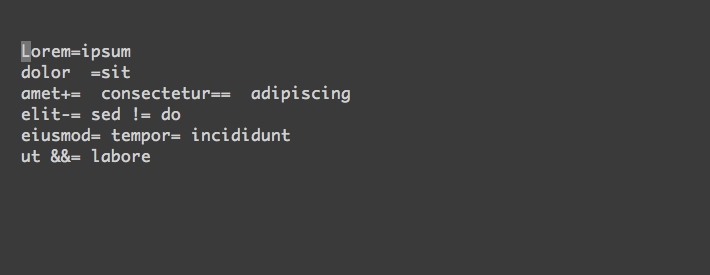
|
|
|
|
Installation
|
|
------------
|
|
|
|
Use your favorite plugin manager.
|
|
|
|
Using [vim-plug](https://github.com/junegunn/vim-plug):
|
|
|
|
```vim
|
|
Plug 'junegunn/vim-easy-align'
|
|
```
|
|
|
|
Quick start guide
|
|
-----------------
|
|
|
|
Add the following mappings to your .vimrc.
|
|
|
|
```vim
|
|
" Start interactive EasyAlign in visual mode (e.g. vipga)
|
|
xmap ga <Plug>(EasyAlign)
|
|
|
|
" Start interactive EasyAlign for a motion/text object (e.g. gaip)
|
|
nmap ga <Plug>(EasyAlign)
|
|
```
|
|
|
|
Then with the following lines of text,
|
|
|
|
```
|
|
apple =red
|
|
grass+=green
|
|
sky-= blue
|
|
```
|
|
|
|
try these commands:
|
|
|
|
- `vipga=`
|
|
- `v`isual-select `i`nner `p`aragraph
|
|
- Start EasyAlign command (`ga`)
|
|
- Align around `=`
|
|
- `gaip=`
|
|
- Start EasyAlign command (`ga`) for `i`nner `p`aragraph
|
|
- Align around `=`
|
|
|
|
Demo
|
|
----
|
|
|
|
*Click on each image to see from the beginning.*
|
|
|
|
### Using predefined alignment rules
|
|
|
|
An *alignment rule* is a predefined set of options for common alignment tasks,
|
|
which is identified by a single character, such as `<Space>`, `=`, `:`, `.`,
|
|
`|`, `&`, `#`, and `,`.
|
|
|
|
#### `=`
|
|
|
|

|
|
|
|
- `=` Around the 1st occurrences
|
|
- `2=` Around the 2nd occurrences
|
|
- `*=` Around all occurrences
|
|
- `**=` Left/Right alternating alignment around all occurrences
|
|
- `<Enter>` Switching between left/right/center alignment modes
|
|
|
|
#### `<Space>`
|
|
|
|

|
|
|
|
- `<Space>` Around the 1st occurrences of whitespaces
|
|
- `2<Space>` Around the 2nd occurrences
|
|
- `-<Space>` Around the last occurrences
|
|
- `<Enter><Enter>2<Space>` Center-alignment around the 2nd occurrences
|
|
|
|
#### `,`
|
|
|
|

|
|
|
|
- The predefined comma-rule places a comma right next to the preceding token
|
|
without margin (`{'stick_to_left': 1, 'left_margin': 0}`)
|
|
- You can change it with `<Right>` arrow
|
|
|
|
### Using regular expression
|
|
|
|
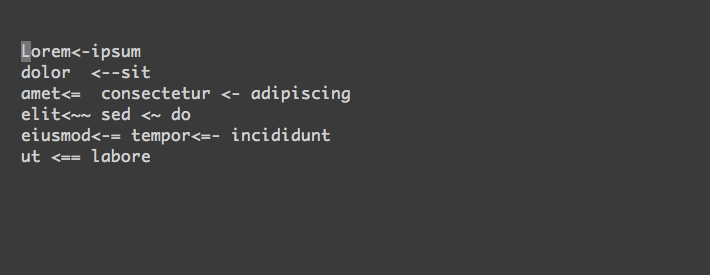
|
|
|
|
You can use an arbitrary regular expression by
|
|
- pressing `<Ctrl-X>` in interactive mode
|
|
- or using `:EasyAlign /REGEX/` command in visual mode or in normal mode with
|
|
a range (e.g. `:%`)
|
|
|
|
### Different ways to start
|
|
|
|
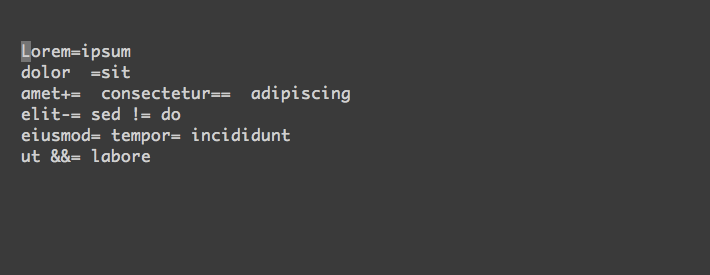
|
|
|
|
This demo shows how you can start interactive mode with visual selection or use
|
|
non-interactive `:EasyAlign` command.
|
|
|
|
### Aligning table cells
|
|
|
|
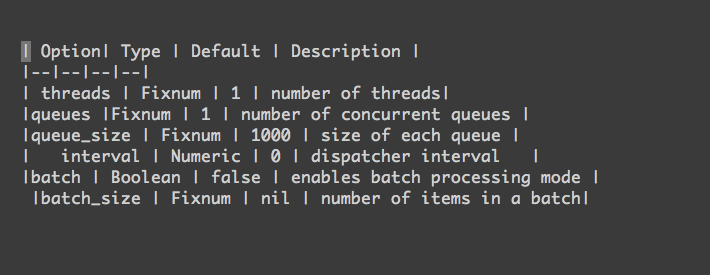
|
|
|
|
Check out various alignment options and "live interactive mode".
|
|
|
|
### Syntax-aware alignment
|
|
|
|
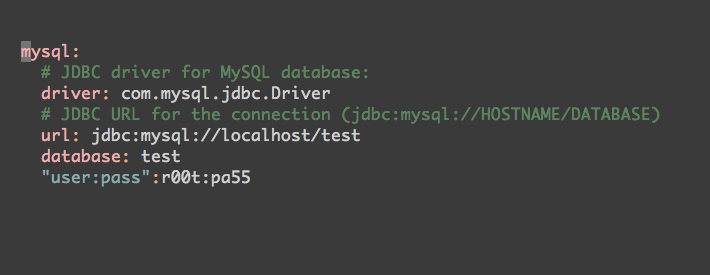
|
|
|
|
Delimiters in strings and comments are ignored by default.
|
|
|
|
### Using blockwise-visual mode
|
|
|
|
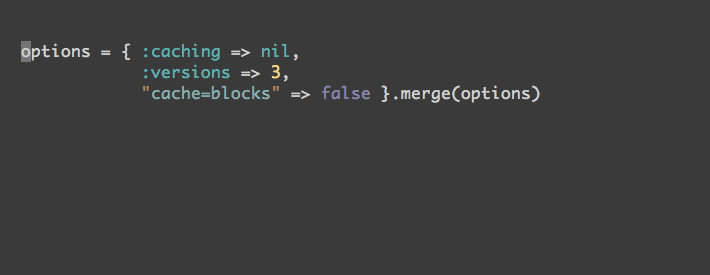
|
|
|
|
You can limit the scope with blockwise-visual mode.
|
|
|
|
Usage
|
|
-----
|
|
|
|
### Flow of execution
|
|
|
|
<img src="https://raw.githubusercontent.com/junegunn/i/master/easy-align/usage.png" width="469">
|
|
|
|
There are two ways to use easy-align.
|
|
|
|
#### 1. `<Plug>` mappings (interactive mode)
|
|
|
|
The recommended method is to use `<Plug>(EasyAlign)` mapping in normal and
|
|
visual mode. They are usually mapped to `ga`, but you can choose any key
|
|
sequences.
|
|
|
|
```vim
|
|
nmap ga <Plug>(EasyAlign)
|
|
xmap ga <Plug>(EasyAlign)
|
|
```
|
|
|
|
1. `ga` key in visual mode, or `ga` followed by a motion or a text
|
|
object to start interactive mode
|
|
1. (Optional) Enter keys to cycle between alignment mode (left, right, or center)
|
|
1. (Optional) N-th delimiter (default: 1)
|
|
- `1` Around the 1st occurrences of delimiters
|
|
- `2` Around the 2nd occurrences of delimiters
|
|
- ...
|
|
- `*` Around all occurrences of delimiters
|
|
- `**` Left-right alternating alignment around all delimiters
|
|
- `-` Around the last occurrences of delimiters (`-1`)
|
|
- `-2` Around the second to last occurrences of delimiters
|
|
- ...
|
|
1. Delimiter key (a single keystroke; `<Space>`, `=`, `:`, `.`, `|`, `&`, `#`, `,`) or an arbitrary regular expression followed by `<CTRL-X>`
|
|
|
|
#### 2. Using `:EasyAlign` command
|
|
|
|
If you prefer command-line, use `:EasyAlign` command instead.
|
|
|
|
```vim
|
|
" Using predefined rules
|
|
:EasyAlign[!] [N-th] DELIMITER_KEY [OPTIONS]
|
|
|
|
" Using regular expression
|
|
:EasyAlign[!] [N-th] /REGEXP/ [OPTIONS]
|
|
```
|
|
|
|
### Regular expression vs. predefined rules
|
|
|
|
You can use regular expressions but it's usually much easier to use predefined
|
|
alignment rules that you can trigger with a single keystroke.
|
|
|
|
| Key | Description/Use cases |
|
|
| --------- | -------------------------------------------------------------------- |
|
|
| `<Space>` | General alignment around whitespaces |
|
|
| `=` | Operators containing equals sign (`=`, `==,` `!=`, `+=`, `&&=`, ...) |
|
|
| `:` | Suitable for formatting JSON or YAML |
|
|
| `.` | Multi-line method chaining |
|
|
| `,` | Multi-line method arguments |
|
|
| `&` | LaTeX tables (matches `&` and `\\`) |
|
|
| `#` | Ruby/Python comments |
|
|
| `"` | Vim comments |
|
|
| `<Bar>` | Table markdown |
|
|
|
|
You can also define your own rules with `g:easy_align_delimiters` which will
|
|
be described in [the later section](#extending-alignment-rules).
|
|
|
|
----
|
|
|
|
### Interactive mode
|
|
|
|
Interactive mode is started either with `<Plug>(EasyAlign)` mapping or with
|
|
`:EasyAlign` command with no argument.
|
|
|
|
#### Examples using predefined rules
|
|
|
|
| Keystrokes | Description | Equivalent command |
|
|
| ------------ | ---------------------------------- | --------------------- |
|
|
| `<Space>` | Around 1st whitespaces | `:'<,'>EasyAlign\ ` |
|
|
| `2<Space>` | Around 2nd whitespaces | `:'<,'>EasyAlign2\ ` |
|
|
| `-<Space>` | Around the last whitespaces | `:'<,'>EasyAlign-\ ` |
|
|
| `-2<Space>` | Around the 2nd to last whitespaces | `:'<,'>EasyAlign-2\ ` |
|
|
| `:` | Around 1st colon (`key: value`) | `:'<,'>EasyAlign:` |
|
|
| `<Right>:` | Around 1st colon (`key : value`) | `:'<,'>EasyAlign:>l1` |
|
|
| `=` | Around 1st operators with = | `:'<,'>EasyAlign=` |
|
|
| `3=` | Around 3rd operators with = | `:'<,'>EasyAlign3=` |
|
|
| `*=` | Around all operators with = | `:'<,'>EasyAlign*=` |
|
|
| `**=` | Left-right alternating around = | `:'<,'>EasyAlign**=` |
|
|
| `<Enter>=` | Right alignment around 1st = | `:'<,'>EasyAlign!=` |
|
|
| `<Enter>**=` | Right-left alternating around = | `:'<,'>EasyAlign!**=` |
|
|
|
|
Instead of finishing the alignment with a delimiter key, you can type in
|
|
a regular expression if you press `<CTRL-/>` or `<CTRL-X>`.
|
|
|
|
#### Alignment options in interactive mode
|
|
|
|
While in interactive mode, you can set alignment options using special shortcut
|
|
keys listed below. The meaning of each option will be described in
|
|
[the following sections](#alignment-options).
|
|
|
|
| Key | Option | Values |
|
|
| --------- | ------------------ | -------------------------------------------------- |
|
|
| `CTRL-F` | `filter` | Input string (`[gv]/.*/?`) |
|
|
| `CTRL-I` | `indentation` | shallow, deep, none, keep |
|
|
| `CTRL-L` | `left_margin` | Input number or string |
|
|
| `CTRL-R` | `right_margin` | Input number or string |
|
|
| `CTRL-D` | `delimiter_align` | left, center, right |
|
|
| `CTRL-U` | `ignore_unmatched` | 0, 1 |
|
|
| `CTRL-G` | `ignore_groups` | `[]`, `['String']`, `['Comment']`, `['String', 'Comment']` |
|
|
| `CTRL-A` | `align` | Input string (`/[lrc]+\*{0,2}/`) |
|
|
| `<Left>` | `stick_to_left` | `{ 'stick_to_left': 1, 'left_margin': 0 }` |
|
|
| `<Right>` | `stick_to_left` | `{ 'stick_to_left': 0, 'left_margin': 1 }` |
|
|
| `<Down>` | `*_margin` | `{ 'left_margin': 0, 'right_margin': 0 }` |
|
|
|
|
#### Live interactive mode
|
|
|
|
If you're performing a complex alignment where multiple options should be
|
|
carefully adjusted, try "live interactive mode" where you can preview the result
|
|
of the alignment on-the-fly as you type in.
|
|
|
|
Live interactive mode can be started with either `<Plug>(LiveEasyAlign)` map
|
|
or `:LiveEasyAlign` command. Or you can switch to live interactive mode while
|
|
in ordinary interactive mode by pressing `<CTRL-P>`. (P for Preview)
|
|
|
|
In live interactive mode, you have to type in the same delimiter (or
|
|
`<CTRL-X>` on regular expression) again to finalize the alignment. This allows
|
|
you to preview the result of the alignment and freely change the delimiter
|
|
using backspace key without leaving the interactive mode.
|
|
|
|
### :EasyAlign command
|
|
|
|
Instead of starting interactive mode, you can use non-interactive `:EasyAlign`
|
|
command.
|
|
|
|
```vim
|
|
" Using predefined alignment rules
|
|
" :EasyAlign[!] [N-th] DELIMITER_KEY [OPTIONS]
|
|
:EasyAlign :
|
|
:EasyAlign =
|
|
:EasyAlign *=
|
|
:EasyAlign 3\
|
|
|
|
" Using arbitrary regular expressions
|
|
" :EasyAlign[!] [N-th] /REGEXP/ [OPTIONS]
|
|
:EasyAlign /[:;]\+/
|
|
:EasyAlign 2/[:;]\+/
|
|
:EasyAlign */[:;]\+/
|
|
:EasyAlign **/[:;]\+/
|
|
```
|
|
|
|
A command can end with alignment options, [each of which will be discussed in
|
|
detail later](#alignment-options), in Vim dictionary format.
|
|
|
|
- `:EasyAlign * /[:;]\+/ { 'stick_to_left': 1, 'left_margin': 0 }`
|
|
|
|
`stick_to_left` of 1 means that the matched delimiter should be positioned right
|
|
next to the preceding token, and `left_margin` of 0 removes the margin on the
|
|
left. So we get:
|
|
|
|
apple;: banana:: cake
|
|
data;; exchange:; format
|
|
|
|
You don't have to write complete names as long as they're distinguishable.
|
|
|
|
- `:EasyAlign * /[:;]\+/ { 'stl': 1, 'l': 0 }`
|
|
|
|
You can even omit spaces between the arguments.
|
|
|
|
- `:EasyAlign*/[:;]\+/{'s':1,'l':0}`
|
|
|
|
Nice. But let's make it even shorter. Option values can be written in shorthand
|
|
notation.
|
|
|
|
- `:EasyAlign*/[:;]\+/<l0`
|
|
|
|
The following table summarizes the shorthand notation.
|
|
|
|
| Option | Expression |
|
|
| ------------------ | -------------- |
|
|
| `filter` | `[gv]/.*/` |
|
|
| `left_margin` | `l[0-9]+` |
|
|
| `right_margin` | `r[0-9]+` |
|
|
| `stick_to_left` | `<` or `>` |
|
|
| `ignore_unmatched` | `iu[01]` |
|
|
| `ignore_groups` | `ig\[.*\]` |
|
|
| `align` | `a[lrc*]*` |
|
|
| `delimiter_align` | `d[lrc]` |
|
|
| `indentation` | `i[ksdn]` |
|
|
|
|
### Partial alignment in blockwise-visual mode
|
|
|
|
In blockwise-visual mode (`CTRL-V`), EasyAlign command aligns only the selected
|
|
text in the block, instead of the whole lines in the range.
|
|
|
|
Consider the following case where you want to align text around `=>` operators.
|
|
|
|
```ruby
|
|
my_hash = { :a => 1,
|
|
:aa => 2,
|
|
:aaa => 3 }
|
|
```
|
|
|
|
In non-blockwise visual mode (`v` / `V`), `<Enter>=` won't work since the
|
|
assignment operator in the first line gets in the way. So we instead enter
|
|
blockwise-visual mode (`CTRL-V`), and select the text *around*
|
|
`=>` operators, then press `<Enter>=`.
|
|
|
|
```ruby
|
|
my_hash = { :a => 1,
|
|
:aa => 2,
|
|
:aaa => 3 }
|
|
```
|
|
|
|
However, in this case, we don't really need blockwise visual mode
|
|
since the same can be easily done using the negative N-th parameter: `<Enter>-=`
|
|
|
|
|
|
Alignment options
|
|
-----------------
|
|
|
|
### List of options
|
|
|
|
| Option | Type | Default | Description |
|
|
| ------------------ | ------- | --------------------- | ------------------------------------------------------- |
|
|
| `filter` | string | | Line filtering expression: `g/../` or `v/../` |
|
|
| `left_margin` | number | 1 | Number of spaces to attach before delimiter |
|
|
| `left_margin` | string | `' '` | String to attach before delimiter |
|
|
| `right_margin` | number | 1 | Number of spaces to attach after delimiter |
|
|
| `right_margin` | string | `' '` | String to attach after delimiter |
|
|
| `stick_to_left` | boolean | 0 | Whether to position delimiter on the left-side |
|
|
| `ignore_groups` | list | ['String', 'Comment'] | Delimiters in these syntax highlight groups are ignored |
|
|
| `ignore_unmatched` | boolean | 1 | Whether to ignore lines without matching delimiter |
|
|
| `indentation` | string | `k` | Indentation method (*k*eep, *d*eep, *s*hallow, *n*one) |
|
|
| `delimiter_align` | string | `r` | Determines how to align delimiters of different lengths |
|
|
| `align` | string | `l` | Alignment modes for multiple occurrences of delimiters |
|
|
|
|
There are 4 ways to set alignment options (from lowest precedence to highest):
|
|
|
|
1. Some option values can be set with corresponding global variables
|
|
2. Option values can be specified in the definition of each alignment rule
|
|
3. Option values can be given as arguments to `:EasyAlign` command
|
|
4. Option values can be set in interactive mode using special shortcut keys
|
|
|
|
| Option name | Shortcut key | Abbreviated | Global variable |
|
|
| ------------------ | ------------------- | -------------- | ------------------------------- |
|
|
| `filter` | `CTRL-F` | `[gv]/.*/` | |
|
|
| `left_margin` | `CTRL-L` | `l[0-9]+` | |
|
|
| `right_margin` | `CTRL-R` | `r[0-9]+` | |
|
|
| `stick_to_left` | `<Left>`, `<Right>` | `<` or `>` | |
|
|
| `ignore_groups` | `CTRL-G` | `ig\[.*\]` | `g:easy_align_ignore_groups` |
|
|
| `ignore_unmatched` | `CTRL-U` | `iu[01]` | `g:easy_align_ignore_unmatched` |
|
|
| `indentation` | `CTRL-I` | `i[ksdn]` | `g:easy_align_indentation` |
|
|
| `delimiter_align` | `CTRL-D` | `d[lrc]` | `g:easy_align_delimiter_align` |
|
|
| `align` | `CTRL-A` | `a[lrc*]*` | |
|
|
|
|
### Filtering lines
|
|
|
|
With `filter` option, you can align lines that only match or do not match a
|
|
given pattern. There are several ways to set the pattern.
|
|
|
|
1. Press `CTRL-F` in interactive mode and type in `g/pat/` or `v/pat/`
|
|
2. In command-line, it can be written in dictionary format: `{'filter': 'g/pat/'}`
|
|
3. Or in shorthand notation: `g/pat/` or `v/pat/`
|
|
|
|
(You don't need to escape '/'s in the regular expression)
|
|
|
|
#### Examples
|
|
|
|
```vim
|
|
" Start interactive mode with filter option set to g/hello/
|
|
EasyAlign g/hello/
|
|
|
|
" Start live interactive mode with filter option set to v/goodbye/
|
|
LiveEasyAlign v/goodbye/
|
|
|
|
" Align the lines with 'hi' around the first colons
|
|
EasyAlign:g/hi/
|
|
```
|
|
|
|
### Ignoring delimiters in comments or strings
|
|
|
|
EasyAlign can be configured to ignore delimiters in certain syntax highlight
|
|
groups, such as code comments or strings. By default, delimiters that are
|
|
highlighted as code comments or strings are ignored.
|
|
|
|
```vim
|
|
" Default:
|
|
" If a delimiter is in a highlight group whose name matches
|
|
" any of the following regular expressions, it will be ignored.
|
|
let g:easy_align_ignore_groups = ['Comment', 'String']
|
|
```
|
|
|
|
For example, the following paragraph
|
|
|
|
```ruby
|
|
{
|
|
# Quantity of apples: 1
|
|
apple: 1,
|
|
# Quantity of bananas: 2
|
|
bananas: 2,
|
|
# Quantity of grape:fruits: 3
|
|
'grape:fruits': 3
|
|
}
|
|
```
|
|
|
|
becomes as follows on `<Enter>:` (or `:EasyAlign:`)
|
|
|
|
```ruby
|
|
{
|
|
# Quantity of apples: 1
|
|
apple: 1,
|
|
# Quantity of bananas: 2
|
|
bananas: 2,
|
|
# Quantity of grape:fruits: 3
|
|
'grape:fruits': 3
|
|
}
|
|
```
|
|
|
|
Naturally, this feature only works when syntax highlighting is enabled.
|
|
|
|
You can change the default rule by using one of these 4 methods.
|
|
|
|
1. Press `CTRL-G` in interactive mode to switch groups
|
|
2. Define global `g:easy_align_ignore_groups` list
|
|
3. Define a custom rule in `g:easy_align_delimiters` with `ignore_groups` option
|
|
4. Provide `ignore_groups` option to `:EasyAlign` command.
|
|
e.g. `:EasyAlign:ig[]`
|
|
|
|
For example if you set `ignore_groups` option to be an empty list, you get
|
|
|
|
```ruby
|
|
{
|
|
# Quantity of apples: 1
|
|
apple: 1,
|
|
# Quantity of bananas: 2
|
|
bananas: 2,
|
|
# Quantity of grape: fruits: 3
|
|
'grape: fruits': 3
|
|
}
|
|
```
|
|
|
|
If a pattern in `ignore_groups` is prepended by a `!`, it will have the opposite
|
|
meaning. For instance, if `ignore_groups` is given as `['!Comment']`, delimiters
|
|
that are *not* highlighted as Comment will be ignored during the alignment.
|
|
|
|
To make `ignore_groups` work, and to debug the related issues, it is useful to
|
|
know which highlight group a certain location in a file belongs to. A special
|
|
function exists for this purpose, returning exactly the name of the highlight
|
|
group that is used by the easy align plugin.
|
|
|
|
```vim
|
|
" Highlight group name of the cursor position
|
|
echo easy_align#get_highlight_group_name()
|
|
|
|
" Highlight group name of the line 10, column 20
|
|
echo easy_align#get_highlight_group_name(10, 20)
|
|
```
|
|
|
|
### Ignoring unmatched lines
|
|
|
|
`ignore_unmatched` option determines how EasyAlign command processes lines that
|
|
do not have N-th delimiter.
|
|
|
|
1. In left-alignment mode, they are ignored
|
|
2. In right or center-alignment mode, they are *not* ignored, and the last
|
|
tokens from those lines are aligned as well as if there is an invisible
|
|
trailing delimiter at the end of each line
|
|
3. If `ignore_unmatched` is 1, they are ignored regardless of the alignment mode
|
|
4. If `ignore_unmatched` is 0, they are *not* ignored regardless of the mode
|
|
|
|
Let's take an example.
|
|
When we align the following code block around the (1st) colons,
|
|
|
|
```ruby
|
|
{
|
|
apple: proc {
|
|
this_line_does_not_have_a_colon
|
|
},
|
|
bananas: 2,
|
|
grapefruits: 3
|
|
}
|
|
```
|
|
|
|
this is usually what we want.
|
|
|
|
```ruby
|
|
{
|
|
apple: proc {
|
|
this_line_does_not_have_a_colon
|
|
},
|
|
bananas: 2,
|
|
grapefruits: 3
|
|
}
|
|
```
|
|
|
|
However, we can override this default behavior by setting `ignore_unmatched`
|
|
option to zero using one of the following methods.
|
|
|
|
1. Press `CTRL-U` in interactive mode to toggle `ignore_unmatched` option
|
|
2. Set the global `g:easy_align_ignore_unmatched` variable to 0
|
|
3. Define a custom alignment rule with `ignore_unmatched` option set to 0
|
|
4. Provide `ignore_unmatched` option to `:EasyAlign` command. e.g. `:EasyAlign:iu0`
|
|
|
|
Then we get,
|
|
|
|
```ruby
|
|
{
|
|
apple: proc {
|
|
this_line_does_not_have_a_colon
|
|
},
|
|
bananas: 2,
|
|
grapefruits: 3
|
|
}
|
|
```
|
|
|
|
### Aligning delimiters of different lengths
|
|
|
|
Global `g:easy_align_delimiter_align` option and rule-wise/command-wise
|
|
`delimiter_align` option determines how matched delimiters of different lengths
|
|
are aligned.
|
|
|
|
```ruby
|
|
apple = 1
|
|
banana += apple
|
|
cake ||= banana
|
|
```
|
|
|
|
By default, delimiters are right-aligned as follows.
|
|
|
|
```ruby
|
|
apple = 1
|
|
banana += apple
|
|
cake ||= banana
|
|
```
|
|
|
|
However, with `:EasyAlign=dl`, delimiters are left-aligned.
|
|
|
|
```ruby
|
|
apple = 1
|
|
banana += apple
|
|
cake ||= banana
|
|
```
|
|
|
|
And on `:EasyAlign=dc`, center-aligned.
|
|
|
|
```ruby
|
|
apple = 1
|
|
banana += apple
|
|
cake ||= banana
|
|
```
|
|
|
|
In interactive mode, you can change the option value with `CTRL-D` key.
|
|
|
|
### Adjusting indentation
|
|
|
|
By default :EasyAlign command keeps the original indentation of the lines. But
|
|
then again we have `indentation` option. See the following example.
|
|
|
|
```ruby
|
|
# Lines with different indentation
|
|
apple = 1
|
|
banana = 2
|
|
cake = 3
|
|
daisy = 4
|
|
eggplant = 5
|
|
|
|
# Default: _k_eep the original indentation
|
|
# :EasyAlign=
|
|
apple = 1
|
|
banana = 2
|
|
cake = 3
|
|
daisy = 4
|
|
eggplant = 5
|
|
|
|
# Use the _s_hallowest indentation among the lines
|
|
# :EasyAlign=is
|
|
apple = 1
|
|
banana = 2
|
|
cake = 3
|
|
daisy = 4
|
|
eggplant = 5
|
|
|
|
# Use the _d_eepest indentation among the lines
|
|
# :EasyAlign=id
|
|
apple = 1
|
|
banana = 2
|
|
cake = 3
|
|
daisy = 4
|
|
eggplant = 5
|
|
|
|
# Indentation: _n_one
|
|
# :EasyAlign=in
|
|
apple = 1
|
|
banana = 2
|
|
cake = 3
|
|
daisy = 4
|
|
eggplant = 5
|
|
```
|
|
|
|
In interactive mode, you can change the option value with `CTRL-I` key.
|
|
|
|
### Alignments over multiple occurrences of delimiters
|
|
|
|
As stated above, "N-th" parameter is used to target specific occurrences of
|
|
the delimiter when it appears multiple times in each line.
|
|
|
|
To recap:
|
|
|
|
```vim
|
|
" Left-alignment around the FIRST occurrences of delimiters
|
|
:EasyAlign =
|
|
|
|
" Left-alignment around the SECOND occurrences of delimiters
|
|
:EasyAlign 2=
|
|
|
|
" Left-alignment around the LAST occurrences of delimiters
|
|
:EasyAlign -=
|
|
|
|
" Left-alignment around ALL occurrences of delimiters
|
|
:EasyAlign *=
|
|
|
|
" Left-right ALTERNATING alignment around all occurrences of delimiters
|
|
:EasyAlign **=
|
|
|
|
" Right-left ALTERNATING alignment around all occurrences of delimiters
|
|
:EasyAlign! **=
|
|
```
|
|
|
|
In addition to these, you can fine-tune alignments over multiple occurrences
|
|
of the delimiters with 'align' option. (The option can also be set in
|
|
interactive mode with the special key `CTRL-A`)
|
|
|
|
```vim
|
|
" Left alignment over the first two occurrences of delimiters
|
|
:EasyAlign = { 'align': 'll' }
|
|
|
|
" Right, left, center alignment over the 1st to 3rd occurrences of delimiters
|
|
:EasyAlign = { 'a': 'rlc' }
|
|
|
|
" Using shorthand notation
|
|
:EasyAlign = arlc
|
|
|
|
" Right, left, center alignment over the 2nd to 4th occurrences of delimiters
|
|
:EasyAlign 2=arlc
|
|
|
|
" (*) Repeating alignments (default: l, r, or c)
|
|
" Right, left, center, center, center, center, ...
|
|
:EasyAlign *=arlc
|
|
|
|
" (**) Alternating alignments (default: lr or rl)
|
|
" Right, left, center, right, left, center, ...
|
|
:EasyAlign **=arlc
|
|
|
|
" Right, left, center, center, center, ... repeating alignment
|
|
" over the 3rd to the last occurrences of delimiters
|
|
:EasyAlign 3=arlc*
|
|
|
|
" Right, left, center, right, left, center, ... alternating alignment
|
|
" over the 3rd to the last occurrences of delimiters
|
|
:EasyAlign 3=arlc**
|
|
```
|
|
|
|
### Extending alignment rules
|
|
|
|
Although the default rules should cover the most of the use cases,
|
|
you can extend the rules by setting a dictionary named `g:easy_align_delimiters`.
|
|
|
|
You may refer to the definitions of the default alignment rules
|
|
[here](https://github.com/junegunn/vim-easy-align/blob/2.9.6/autoload/easy_align.vim#L32-L46).
|
|
|
|
#### Examples
|
|
|
|
```vim
|
|
let g:easy_align_delimiters = {
|
|
\ '>': { 'pattern': '>>\|=>\|>' },
|
|
\ '/': {
|
|
\ 'pattern': '//\+\|/\*\|\*/',
|
|
\ 'delimiter_align': 'l',
|
|
\ 'ignore_groups': ['!Comment'] },
|
|
\ ']': {
|
|
\ 'pattern': '[[\]]',
|
|
\ 'left_margin': 0,
|
|
\ 'right_margin': 0,
|
|
\ 'stick_to_left': 0
|
|
\ },
|
|
\ ')': {
|
|
\ 'pattern': '[()]',
|
|
\ 'left_margin': 0,
|
|
\ 'right_margin': 0,
|
|
\ 'stick_to_left': 0
|
|
\ },
|
|
\ 'd': {
|
|
\ 'pattern': ' \(\S\+\s*[;=]\)\@=',
|
|
\ 'left_margin': 0,
|
|
\ 'right_margin': 0
|
|
\ }
|
|
\ }
|
|
```
|
|
|
|
Other options
|
|
-------------
|
|
|
|
### Disabling &foldmethod during alignment
|
|
|
|
[It is reported](https://github.com/junegunn/vim-easy-align/issues/14) that
|
|
`&foldmethod` value of `expr` or `syntax` can significantly slow down the
|
|
alignment when editing a large, complex file with many folds. To alleviate this
|
|
issue, EasyAlign provides an option to temporarily set `&foldmethod` to `manual`
|
|
during the alignment task. In order to enable this feature, set
|
|
`g:easy_align_bypass_fold` switch to 1.
|
|
|
|
```vim
|
|
let g:easy_align_bypass_fold = 1
|
|
```
|
|
|
|
### Left/right/center mode switch in interactive mode
|
|
|
|
In interactive mode, you can choose the alignment mode you want by pressing
|
|
enter keys. The non-bang command, `:EasyAlign` starts in left-alignment mode
|
|
and changes to right and center mode as you press enter keys, while the bang
|
|
version first starts in right-alignment mode.
|
|
|
|
- `:EasyAlign`
|
|
- Left, Right, Center
|
|
- `:EasyAlign!`
|
|
- Right, Left, Center
|
|
|
|
If you do not prefer this default mode transition, you can define your own
|
|
settings as follows.
|
|
|
|
```vim
|
|
let g:easy_align_interactive_modes = ['l', 'r']
|
|
let g:easy_align_bang_interactive_modes = ['c', 'r']
|
|
```
|
|
|
|
Advanced examples and use cases
|
|
-------------------------------
|
|
|
|
See [EXAMPLES.md](https://github.com/junegunn/vim-easy-align/blob/master/EXAMPLES.md)
|
|
for more examples.
|
|
|
|
Related work
|
|
------------
|
|
|
|
- [DrChip's Alignment Tool for Vim](http://www.drchip.org/astronaut/vim/align.html)
|
|
- [Tabular](https://github.com/godlygeek/tabular)
|
|
|
|
Author
|
|
------
|
|
|
|
[Junegunn Choi](https://github.com/junegunn)
|
|
|
|
License
|
|
-------
|
|
|
|
MIT
|